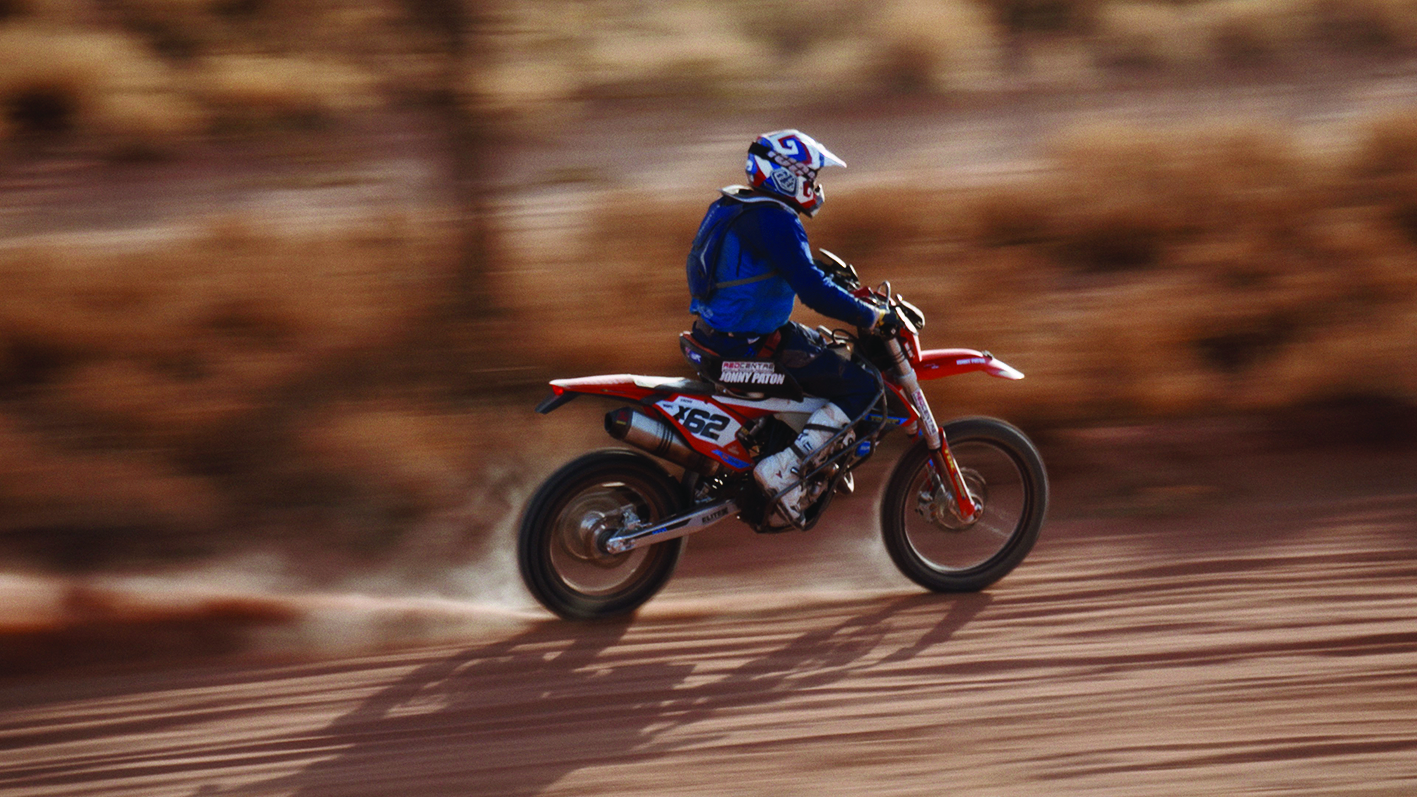Twenty minutes into Finke: There and Back (Dylan River, 2018), there’s a scene in which a mixture of competition officials, police and medical staff are all in a meeting, planning for the inevitable injuries that will happen as a result of the upcoming race. They talk through contingency plans in case of a death, and one medical worker points out that history has shown that there are roughly sixty extra presentations to the emergency department over the course of Finke weekend, with twenty of these being serious injuries.
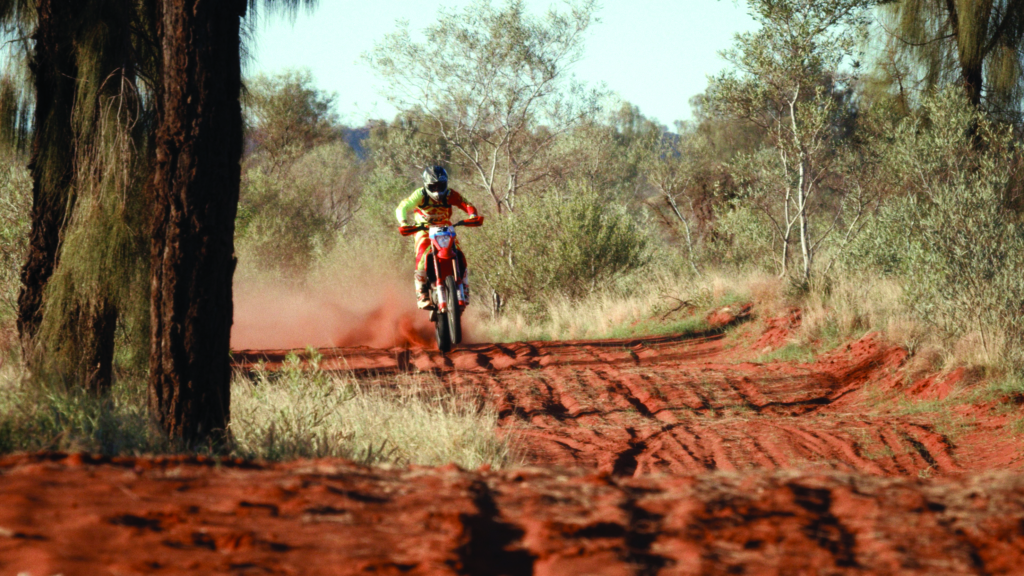
This is the reality of the Finke Desert Race, an epic journey that sees participants travel approximately 230 kilometres each way over the course of two days. The race first took place in 1976 and, originally, was pretty basic: a small group of dirt-bike riders raced from Alice Springs to the town of Finke (known to traditional-land owners as Aputula[1]‘Finke’, Macdonnell Regional Council website, <https://www.macdonnell.nt.gov.au/communities/finke>, accessed 19 February 2020. ). Over the years, however, the race has grown. A separate car race was added in 1988, and Finke is now so popular that dirt-bike participant numbers are capped at around 650 – with the waiting list including over a hundred more candidates.[2]‘About the Finke Desert Race’, Finke Desert Race website, <https://finkedesertrace.com.au/28-about-us/120-about-finke>; and ‘Bike Competitor Information’, Finke Desert Race website, , both accessed 19 February 2020.
For outsiders, it might be hard to believe that anyone would willingly take part in the Finke Desert Race – let alone the fact that interest is so high that many hopefuls are turned away. The track is off-road and treacherous. Injuries are expected; deaths, though rare, have happened.[3]See, for example, Nikkii Joyce, ‘Rider’s Death Delivers Double Tragedy’, The Chronicle, 11 June 2008, <https://www.thechronicle.com.au/news/riders-death-delivers-double-tragedy/22190/>; and Ellie Turner, ‘Teen Dies of Injuries After Dirt Bike Crash’, NT News, 28 February 2013, p. 9, available at <https://territorystories.nt.gov.au/jspui/bitstream/10070/244333/9/ntn28feb13009x.pdf>, both accessed 19 February 2020. And 458 kilometres is a whole lot of distance in which something can go wrong. So why do it?
‘Motorcycle racing … is an extremely rewarding thing – the feeling, the rush, the adrenaline. But it comes with everything we discuss in the film. It comes with the extreme financial burden; it comes with an extreme physical risk; it comes with loss, loss of life.’ —Dylan River
Finke writer/director River is perhaps the person best placed to answer this question. He himself has done the Finke race eight times, starting at the age of sixteen. ‘I think I only finished three out of those eight,’ he tells me with a laugh. In the film, he not only looks at the simultaneously brutal and joyous realities of the race, but also probes what the appeal is – teasing out exactly what makes people spend big, travel far and risk their lives.
‘Everyone has their own answer to that question; there’s no right or wrong answer,’ he reflects.
And that’s what’s so great about this race: how many different sorts of people it does appeal to – from the athlete who’s getting paid to do it, to someone who just really, really wants to be a part of the event […] or wants to finish it, tick it off a bucket list.
The danger of the race is a constant spectre within the documentary. Finke begins with a bird’s-eye-view shot over Alice Springs, with sound bites from different interviewees talking about their own experiences and explaining that you can’t really tell people what it’s like to race that they have to live it. There’s footage from the point of view of a rider bumping along the dirt track before tipping over. Another overhead shot shows bikes on the ground, with an audio clip from the race declaring, ‘We’ve got reports of multiple riders down around the 100-kilometre mark.’ The music is tense. River – who took on cinematography duties on top of writing and directing – and sound designer Brendan Croxon use every avenue available to let viewers know from the outset that there is a very real risk to Finke.
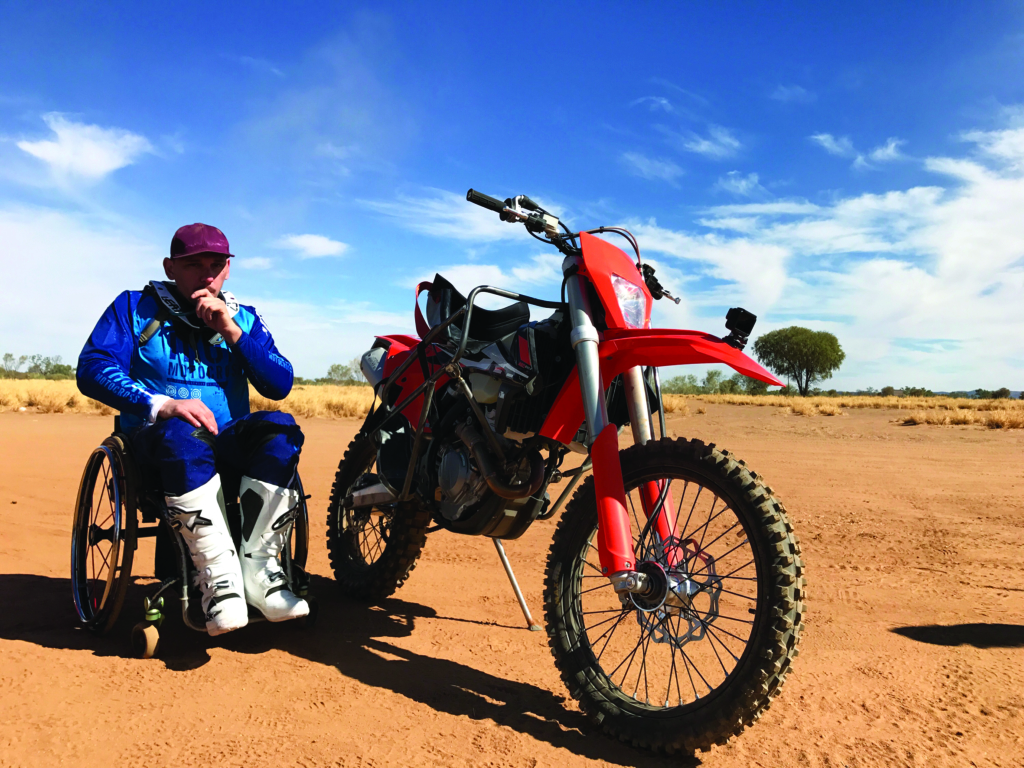
River recounts how, after one screening of his documentary, an audience member who’d previously raced came up to him and said, ‘It’s a disease. It’s a fucking disease, man.’ He laughs, then remarks:
It’s very true. Motorcycle racing is a ‘disease’. And you’re very unfortunate if you get that disease and become addicted to riding, basically because it is an extremely rewarding thing – the feeling, the rush, the adrenaline. But it comes with everything we discuss in the film. It comes with the extreme financial burden; it comes with an extreme physical risk; it comes with loss, loss of life.
He pauses. ‘Just the pressure it has on a family for someone to race, whether it’s someone’s kid or someone’s father.’
The documentary skips the cars and focuses purely on the dirt bikes. It makes sense – River is a dirt-bike rider, and the event was originally just for the latter. ‘We showed just enough of [the cars] to show that they’re there. Like I said at the start of the film, this is not their story – this is a story about the bikes.’
‘There’s something when you ride a bike and you perfect a moment in time, and it feels effortless. It feels almost like you’re floating … It’s this feeling of flying. I think that’s the addiction, somewhere in there. And you’re constantly chasing it.’ —Dylan River
Finke tracks several riders as they prepare for and then compete in the 2017 race. The actual year isn’t mentioned in the film because River wanted it to be representative of the event as a whole – not just a single instance of it. ‘This is Finke every year. There’s new characters, there’s new stories that happen, and that’s why we’ve tried to be non-specific about the year. It’s just another Finke.’
Interviewed in River’s film are professional riders and hobbyists alike. There is Daymon Stokie, an underdog with a hand injury. There’s Scruff Hamill, a passionate rider who is fulfilling a long-held dream to race at Finke. And there’s Isaac Elliott, a friend of River’s who, we are informed, is returning to complete the race he started seven years earlier; the last time he took part in a Finke, an accident caused him to become paraplegic. Asked in the film why he is compelled to come back, Elliott says he doesn’t know, then pauses before adding: ‘I miss having some sort of adrenaline outlet.’
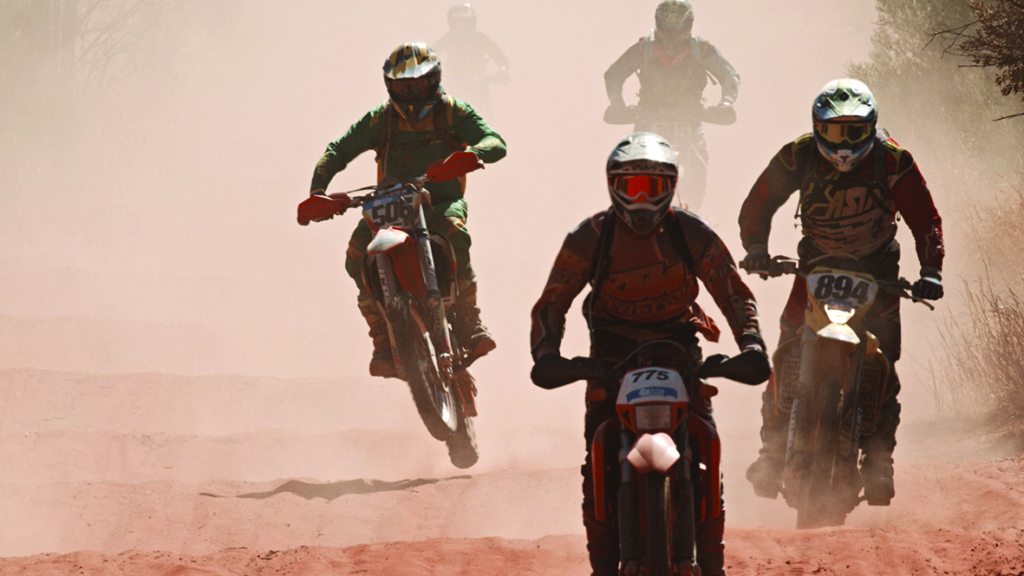
Elliott’s presence in the film is an important one. Even if you theoretically know there is a big risk to doing something, optimism bias leads you to believe that it is less likely to happen to you.[4]See Tali Sharot, ‘The Optimism Bias’, Time, 28 May 2011 <http://content.time.com/time/health/article/0,8599,2074067,00.html>, accessed 19 February 2020. This isn’t the case for Elliott. He has experienced the risks firsthand – yet, for him, the draw of Finke, and of racing in general, is too great.
It’s similar for River. ‘I’ve got countless friends in wheelchairs from the Finke track, Isaac being one of them,’ he says.
I don’t know why, but you’d think that your friend in a wheelchair would definitely turn you off riding, [except] for some reason, it doesn’t. And it doesn’t turn them off the sport, either […] They’ve got a very optimistic view on it.
One thing that River has observed is that, often, family plays a big part in people getting started in racing. ‘It is usually passed down through generations. You see it time and time again with boys who, if their dad was a rugby player, they play rugby; if their dad was a motorbike rider, then they do motorbikes.’

This is definitely the case for Alice Springs local Luke Hayes, another of the documentary’s subjects, who, the year of Finke’s shoot, raced in honour of his father who had recently passed away. Curiously, though, despite his own father – renowned filmmaker Warwick Thornton – being into motorbikes, River sees himself as an outlier to this observation. ‘You have these oddballs like myself or other people I’m friends with who just somehow become very interested in it,’ he reflects.
[I was] so young, being sixteen and trying to race this race with very little support from [my] parents, [and] my dad – even though he was into motorbikes – really wasn’t there the first couple of years I raced. And my mum was really not into it. She was very anti me racing Finke, and so I had to work out a lot of stuff by myself.
Familial resistance to racing is also explored in the documentary: riders compete despite the concerns of spouses and parents, yet they can’t name a concrete reason as to why. The film points to a race a few years back where multiple riders didn’t check in one night and concerns began to mount. Things began to feel even more tense as it turned out each missing rider had a nervous, pregnant partner waiting to hear that they were safe.
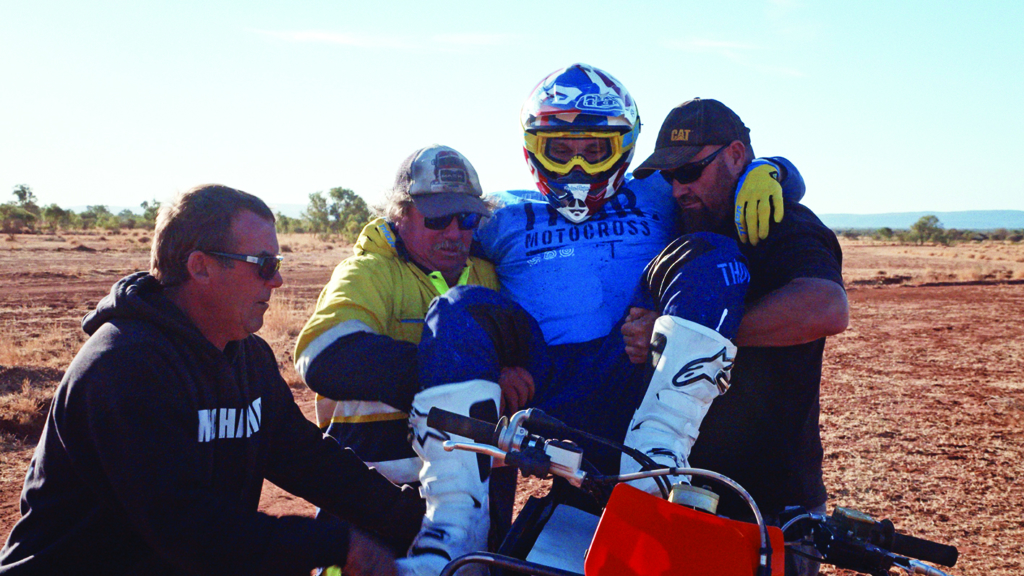
It is tempting to put this ‘need’ to race down to machismo. Asked if it is fair to say that racing is a male-dominated sport, River replies, ‘Oh, it’s absolutely fair to say, I think.’
Times are changing and that’s across the board, but it has been hugely male-dominated, and I think that applies to motorsports in general. They really are behind the times in many, many ways.
Yet, while they definitely make up the majority, men aren’t the only ones who take part in racing. ‘Finke introduced a female class about three [or] four years ago,’ River clarifies. ‘I think we’re seeing about thirty women racing it now. Next year, you’ll probably see fifty, and it will just be more and more.’
While the documentary does feature a few sound bites from female racers, none of the on-screen interviewees are women. River explains that the production team did follow a few female racers, but, for various reasons, they didn’t end up making the final cut. ‘That’s probably the biggest regret I have […] There was a missed opportunity there.’

One of the most sobering reminders of how dangeous the sport actually is came after filming had wrapped. Stokie, the underdog racer who had won the 2017 race, died while driving in a different event.[5]See ‘Finke Desert Race Champion Daymon Stokie Dies in Motocross Accident’, ABC News, 28 January 2018, <https://www.abc.net.au/news/2018-01-28/finke-desert-champion-daymon-stokie-dies-in-accident/9367994>, accessed 19 February 2020. ‘We were about halfway through the edit when that happened,’ River reflects. It was a rough time, and underscored the importance of using the documentary to explore the deeper questions and motives underlying motorsports – along with, he stresses, ‘the obligation to tell this [story] right’.
River still races, but not to the same degree that he did in his teens. Musing on his reasons behind racing Finke, he says, ‘For me, it was always a competitive thing […] I was trying to prove something to myself or to others around me. And I think I never quite got that.’ As for the documentary, he says he’s ‘still trying to work out why [he] wanted to do [it]’.
It probably had a lot to do with the struggles that I had racing [Finke] – a lot to do with the injuries I had, the mechanical failures, the money and the heartache. It’s sort of just that big question of, ‘Why do we do this?’ Finke the film has tried to talk about all of that.
He adds:
But I think I’ve achieved my goals with Finke in another way by making this film. My impact on the race isn’t necessarily having won it and having my name on that perpetual trophy; now, it’s having made this film that other people can appreciate and remember.
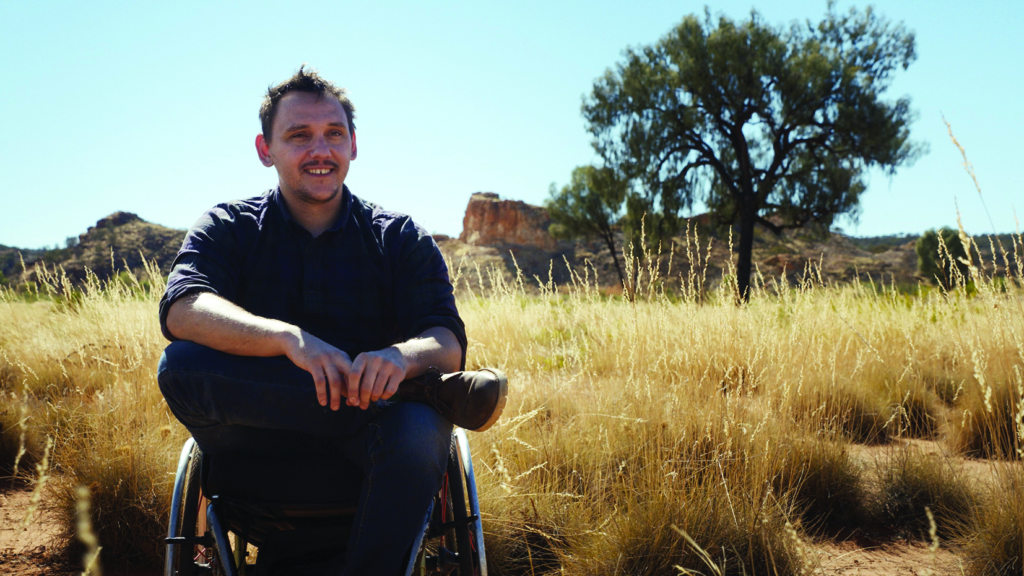
The production was a challenge both intellectually and in terms of execution. River and his team ended up with about 350 hours worth of racing footage shot on dirt roads with no phone reception. There were three helicopters to coordinate, approximately thirty separate camera operatives, and teams of producers and directors dotted around different locations. ‘We essentially shot most of the feature film in two days,’ he says with a chuckle.
Logistically, this race is really hard to race and, logistically, to make a film about it, I think, is even harder. Making this film and filming it that year was harder than any year I actually competed in the race.
Beyond the practical considerations, however, one of the driving forces for the film is getting to the core of why people take part in the titular event. And, while there is no one-size-fits-all answer, River points to the joy of riding during the race itself. Hearing him talk and watching the film, the dangers, the risks, all start to make a strange sense. ‘It has to be about the feeling of freedom,’ he suggests.

There’s something when you ride a bike and you perfect a moment in time, and it feels effortless. It feels almost like you’re floating and […] what you get in the desert with these high speeds on this loose, sandy terrain is a moment where your wheels are actually off the ground more than they’re on the ground […] and you’re suspended. It’s this feeling of flying. I think that’s the addiction, somewhere in there. And you’re constantly chasing it.
People who race motorbikes very rarely ever stop – they always go through this period of, I guess, a retirement where they go, ‘Oh, I’m going to sell the bikes and stop racing.’ But, five years later, they’ve bought another one or they’ve gone for a ride and suddenly they’re back into it again.
https://www.madmanfilms.com.au/finke/
Endnotes
| 1 | ‘Finke’, Macdonnell Regional Council website, <https://www.macdonnell.nt.gov.au/communities/finke>, accessed 19 February 2020. |
|---|---|
| 2 | ‘About the Finke Desert Race’, Finke Desert Race website, <https://finkedesertrace.com.au/28-about-us/120-about-finke>; and ‘Bike Competitor Information’, Finke Desert Race website, , both accessed 19 February 2020. |
| 3 | See, for example, Nikkii Joyce, ‘Rider’s Death Delivers Double Tragedy’, The Chronicle, 11 June 2008, <https://www.thechronicle.com.au/news/riders-death-delivers-double-tragedy/22190/>; and Ellie Turner, ‘Teen Dies of Injuries After Dirt Bike Crash’, NT News, 28 February 2013, p. 9, available at <https://territorystories.nt.gov.au/jspui/bitstream/10070/244333/9/ntn28feb13009x.pdf>, both accessed 19 February 2020. |
| 4 | See Tali Sharot, ‘The Optimism Bias’, Time, 28 May 2011 <http://content.time.com/time/health/article/0,8599,2074067,00.html>, accessed 19 February 2020. |
| 5 | See ‘Finke Desert Race Champion Daymon Stokie Dies in Motocross Accident’, ABC News, 28 January 2018, <https://www.abc.net.au/news/2018-01-28/finke-desert-champion-daymon-stokie-dies-in-accident/9367994>, accessed 19 February 2020. |
